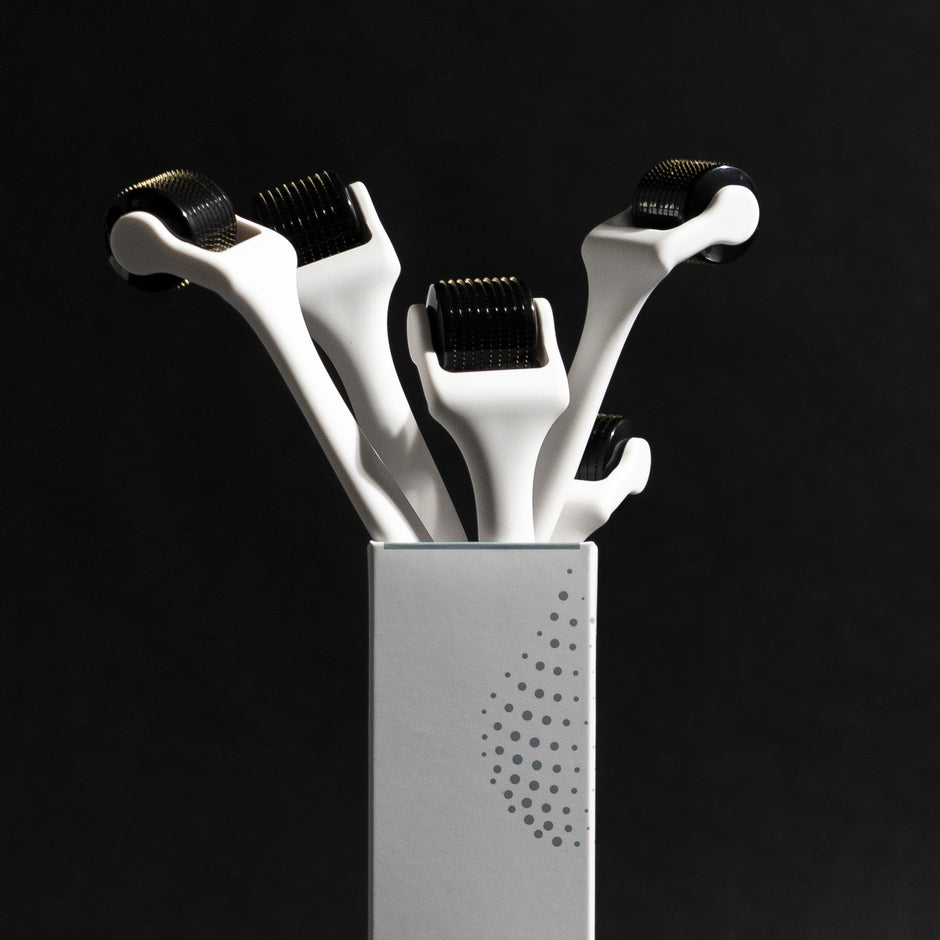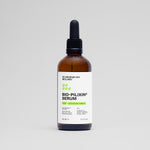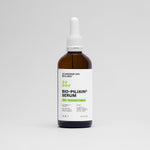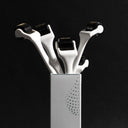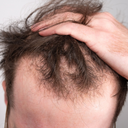The derma roller, a compact tool with tiny, precise needles, may look intimidating at first glance—but don't let its size fool you. This powerful device is rapidly gaining recognition for its ability to stimulate hair regrowth and combat hair thinning, offering a non-invasive, effective solution for anyone seeking healthier, fuller hair.
In this guide, we’ll delve into how the derma roller for hair growth works, its benefits, and how it can help rejuvenate your scalp, boost collagen production, and improve the absorption of hair-boosting serums.
If you’re ready to take control of your hair growth journey, the derma roller might be the game-changing tool you’ve been looking for.
Table of content
What is a derma roller?

A derma roller is a handheld tool used for microneedling. It has a small wheel covered in tiny needles. When rolled over the skin or scalp, it creates microscopic punctures, triggering collagen and elastin production and increased blood flow for skin rejuvenation and hair thickening.
It's designed to induce the body's natural healing mechanisms, primarily through the production of collagen and elastin - proteins that helps rejuvenate skin, restore firmness and elasticity.
It's effective against stretch marks, acne scarring, and fine lines. It also helps to exfoliate dead skin cells, promoting a healthier scalp and hair.
In the realm of hair, its role is to invigorate circulation and increase the potency of topical solutions such as hair loss serums, and oils.
As your leading source for hair health information over the past 4 years, we never compromise on accuracy. When it comes to your health, you deserve information you can truly rely on - and earning your trust is our top priority.
Here's how Scandinavian Biolabs ensures every piece of content meets the highest standards of accuracy and integrity:
- Credentialed Experts: Our reviewers are actively practicing doctors and medical researchers
- Stringent Reviews: Content undergoes rigorous editing by subject specialists and review by a practicing doctor.
- Evidence-Based: We rely on well-established research from trusted scientific sources like peer-reviewed journals and health authorities.
- Full Transparency: Our editorial standards, writer credentials, reviewer credentials, correction process, and funding are all publicly documented.
- Independent Voice: While we do promote products, we operate in a vacuum to business operations. Our main goal is just an unwavering commitment to providing medically-sound guidance.
You can count on Scandinavian Biolabs to consistently deliver the trustworthy health information you deserve. Read our Editorial Standards.
How do derma rollers stimulate hair growth?
Derma rollers stimulate hair growth through microneedling, a process where tiny needles puncture the scalp to promote hair regeneration. This method triggers several key mechanisms:
- Collagen and elastin production: Microneedling boosts the production of collagen and elastin, essential proteins for skin and hair health.
- Blood circulation: The tiny punctures enhance blood flow to the hair follicles, improving nutrient delivery.
- Nutrient absorption: Microscopic channels created by the needles allow oils and serums to penetrate deeper into the scalp, optimizing their effects to improve hair density.
- Growth factor release: Microneedling activates platelets, increasing the release of growth factors that promote skin and hair regeneration.
- Stem cell activation: The tiny wounds activate stem cells in the hair follicles, encouraging hair growth.
- Gene activation: This technique enhances the expression of genes that promote the growth of hair follicles.
In clinical settings, microneedling is often combined with other procedures to enhance its effectiveness. Dermatologists frequently pair it with platelet-rich plasma (PRP) therapy, where PRP is applied to the scalp to further stimulate hair growth. Additionally, low-level light therapy (LLLT) is used alongside microneedling to enhance results.
In a randomized, evaluator-blinded study conducted in 2013, microneedling therapy combined with minoxidil was statistically superior to minoxidil alone in promoting new hair growth. This combination is one of the most promising non-invasive hair loss treatment options available.
How to choose the right derma roller for hair growth?

Selecting the right derma roller involves considering needle size, with 0.5mm to 1.0mm being safe for at-home derma rolling, materials like durable titanium or stainless steel needles, and opting for a reputable brand to ensure quality and safety.
Needle lengths
Derma rollers can have different needle lengths ranging from 0.25 to 1.5 millimeters. For growth, derma rollers with 540 short microneedles (0.5mm) are typically recommended.
Needles ranging from 0.25 mm to under 0.5 mm are ideal for improving the absorption of topical substances like serums and oils.
For stimulating micro trauma, which releases growth factors and promotes hair follicle proliferation, needle lengths between 0.5 mm and 1.5 mm are recommended.
Needles longer than 1.5 mm are not suitable for home use, as they can cause excessive discomfort or injury.
Material
The tiny needles in derma rollers are commonly made from either stainless steel or titanium.
Titanium is durable, long-lasting, stronger, and sharper but requires thorough cleaning to avoid contamination.
INSIDER TIP: It's really rare for suppliers to provide real titanium, most of them are typically gold or silver plated. Unless you are 100% sure, don't spend more on titanium.
Stainless steel is easier to clean and more hygienic due to its smooth, non-porous surface.
Sterilization is crucial for needle lengths over 0.5 mm to prevent infections, making stainless steel a better option for longer needles.
Brand reputation
Always select a derma roller from a reputable brand to ensure the device is of high quality and safe to use.
It's also advisable to read user reviews before purchasing a derma roller to understand its pros and cons from those who have used it.
Remember, the effectiveness of the derma roller not only depends on its use but also on its quality.
How did we test?
Our current ranking is based on aggregated data from customers about the product.
Testing is currently underway to determine the definitive winner of 2025.
5 Best Derma Rollers for New Hair Regrowth
The best derma rollers should use high-quality materials, have a spotless reputation, and have the right needle length. Choosing the best derma rollers is half the battle, already.
🔹 Best Value: Scandinavian Biolabs Scalp Activation Derma Roller – A high-quality, affordable derma roller designed to stimulate the scalp and promote hair growth.
🔹 Best Red Light Roller: BeautyBio GloPRO Regeneration Tools – Features advanced red light therapy to enhance the benefits of micro-needling, promoting hair regrowth and revitalization.
🔹 Best Replaceable Roller: Bosley Micro-Roller – This roller offers replaceable micro-needles for optimal hygiene and maximum results in stimulating hair follicles.
🔹 Best Stainless Steel Roller: Bondi Boost Derma Roller – Made with durable stainless steel needles, this roller provides precision and effectiveness for scalp treatments.
🔹 Best 0.25mm Roller: Act+Acre Scalp Dermaroller – Ideal for beginners, this 0.25mm roller stimulates the scalp gently and encourages healthier hair growth.
We manually vet, look at reviews, and have hands-on testing to ensure these 5 derma rollers work for hair regrowth.
1. Best value: Scandinavian Biolabs Scalp Activation Derma Roller
Designed with 540 stainless steel 0.5mm needles, the Scalp Activation Roller by Scandinavian Biolabs is a top choice for scalp and hair support.
This handheld microneedling tool is specifically designed to stimulate the scalp and encourage fuller hair.
Developed by hair loss experts, for people who wants to stop hair loss.
Our premium, sturdy materials ensure longevity, safety and efficacy all in one product.
Pros
- Developed by the same people who made our Bio-Pilixin® formula
- Stimulates scalp health and hair regrowth
- Safe for everyday use
- Enables professional-like treatments at home
- Excellent quality-to-cost ratio
Cons
- Premium pricing
2. Best red light roller: BeautyBio GloPRO Regeneration Tools

The BeautyBio GloPRO regeneration tools has a unique red light feature. It uses 1260 stainless steel 0.3mm needles, and its red light technology provides an additional boost to hair growth stimulation.
Pros:
- Additional red light technology improves hair density further
- Higher needle count may provide more comprehensive coverage
- Comes from a small business brand
Cons:
- Costs much more due to advanced features
- May not be suitable for beginners due to the higher needle count
- Users reported no results for the money spent
3. Best replaceable roller: Bosley Micro-Roller

This roller has 540 titanium 0.25mm needles. It's known for its durability and effectiveness in stimulating hair growth and improving scalp health.
Pros:
- Weighted, anti-slip handle
- Replaceable head
- Unique ergonomic design
Cons:
- Reviews are impacted by free product to reviewers
4. Best stainless steel: Bondi Boost Derma Roller

The Bondi Boost Derma Roller remains a great option with its high-quality construction and great looks. The main roller consists of 540 needles that are 1.5mm long.
Pros:
- Higher depth of penetration for better hair growth
- Easier to sterilize due to stainless steel
- Sleek design
- Uses medical-grade stainless steel
- Affordable
Cons:
- We cannot find any options for European consumers
- Long needles are not recommended for starters
- Not to be used more than once a week
5. Best 0.25mm: Act+Acre Scalp Dermaroller

The Act+Acre Scalp Derma Roller consists of 540 needles, each 0.25mm in size. While the design is similar to that of Bondi Boost, its shorter needles are good for sensitive skin.
Pros:
- Sleek design
- 0.25mm ideal for sensitive skin
- Trichologist approved
Cons:
- We couldn't find any options for European consumers
- Short needle length might be less effective for hair growth
- More expensive than similar options
- Users reported it pulling their hair out
How do you use a derma roller for hair growth?
To use a derma roller for hair growth, first, sanitize the roller with rubbing alcohol. Apply hair growth serums or oils to the scalp, then gently roll the derma roller over the treatment area in multiple directions. Clean the used at-home derma roller after each use and replace it when necessary, usually after two months or if needles become damaged.
With the right technique, at-home treatments can replicate professional treatment results. Follow these 5 steps to make sure you get the most out of this at-home derma rolling:
1. Sanitise after every use
After using a derma roller, rinse it under warm water and then sanitize it with at least 70% ethyl alcohol cleaner to protect against potential rust.
To sanitize, fill a small container with isopropyl alcohol and submerge the derma roller for about 10-15 minutes. Remove the roller and let it air dry on a clean fabric.
Once dry, store it in a clean, dry container to keep it sanitary. Proper cleaning is crucial as derma rolling creates tiny punctures, and improper cleaning might lead to skin infections. It's also acceptable to clean it before use.
Takeaway: Disinfect with at least 70% ethyl alcohol and let it dry.
2. Apply serums or oils
Now, the question is how to apply minoxidil, hair growth serums, or hair growth oils with a derma roller to grow hair (and facial hair, if that's your jam) more effectively.
We, at Scandinavian Biolabs, believe it starts at picking the right serum.
Our Bio-Pixilin Activation Serum isn't just another hair product.
It's a carefully crafted blend of plant-powered ingredients, tailored to complement your derma roller and maximize its benefits.
It enriches your scalp, and the derma roller ensures that this goodness reaches where it matters the most - your hair follicles.
So, if you're serious about hair growth, consider adding the Bio-Pixilin Activation Serum to your derma roller routine.
It's the missing piece in your hair growth puzzle, and with it, you're one step closer to achieving the fuller hair you've always desired.
After all, when it comes to hair growth, every detail matters.
A cardinal rule: never put the serum on the device itself. You can apply it using the included pipette or cotton balls by sectioning your hair into parts and then massaging your hair.
Remember, it's important to follow the instructions on the label to ensure it works.
Takeaway: Apply products on your scalp first.
3. Derma roll in multiple directions
Start derma rolling or microneedling on clean and wet hair to reduce friction and prevent skin irritation. Gently roll your scalp with light pressure in multiple directions: horizontally, vertically, and diagonally.
The ideal technique involves doing a back-and-forth movement at each site approximately 4-5 times in all four directions, creating overlapping bands for thorough coverage.
Takeaway: Clean your scalp, wet your hair, and derma roll in multiple directions.
4. Replace when necessary
It's important to keep track of how long you've had your derma roller and what condition it's in. A premium derma roller can last a really long time, but, typically, you should think about getting a new derma roller every two months.
If your derma roller gets damaged or broken, you need to stop using it right away. Using a derma roller with bent or damaged needles can hurt your hair follicles and roots.
There are replacement heads for derma rollers that are more budget and environmentally friendly available on the market.
Takeaway: If the needles look crooked or damaged, it's time to toss them and get a new one.
5. Don't disturb the healing process
The healing process shouldn't be rushed or disrupted. As a rule of thumb, allow a few days of healing before you engage in another microneedling session.
Prescribed treatments by doctors include topical antibiotics and low-potency corticosteroids.
Over-the-counter options include aloe vera gel, silicone gel, hyaluronic acid, and ceramides to accelerate healing.
Consult a healthcare professional for personalized recommendations.
Takeaway: Your scalp needs time to heal after each session.
What essential oils are best to use with your derma roller?
Essential oils that complement derma rolling for hair growth include rosemary oil to regulate sebum and boost circulation, lavender oil to encourage hair growth, peppermint oil to stimulate new hair growth and relieve itches, and coconut oil to rejuvenate skin and hair damage prevention.
Lavender oil

Oil from lavender flowers has powerful antibacterial and antifungal properties. The lavender essential oil is effective at stimulating hair growth.
Research published in 2016 indicated that administering lavender oil topically to animals increases growth. In addition, the rate at which their hair grew was much quicker than average.
It is also effective against head lice and other fungal diseases of the scalp that may inhibit hair growth factors.
Combining lavender oil and derma rolling is a great way to make hair grow faster and help treat hair loss.
Rosemary oil

Rosemary oil makes an excellent pairing with derma rollers for several reasons:
- Its lightweight texture doesn't leave your hair feeling oily, keeping your hair fresh after application. It also has proven hair growth properties for androgenetic alopecia (AGA). A study found rosemary oil as effective as minoxidil in promoting hair growth.
- Its ability to regulate sebum production on the scalp. This function keeps your hair and scalp from becoming overly greasy, preventing it from looking weighed down and flat.
- Rosemary oil is rich in antioxidants. These powerful compounds not only delay premature hair greying but also boost scalp circulation, contributing to quicker hair regrowth.
- Rosemary oil addresses the common issue of scalp acne. Thanks to its soothing and antifungal properties, it can alleviate itchiness while keeping the scalp clean and healthy.
Peppermint oil

Peppermint oil works wonders for a scratchy, itchy scalp. Its antimicrobial properties effectively clear the scalp of excess oil and buildup.
One study, backed by a certified organic products agency, explored peppermint oil's hair growth effects compared to other oils. With 100% pure, natural peppermint oil, they discovered that, after four weeks, peppermint oil induced more hair growth than other tested oils.
Peppermint oil also unclogs pores, allowing the skin to breathe. When paired with a derma roller, the oil's penetration into the scalp is enhanced, fostering better hair growth.
Coconut oil

Coconut oil is widely recognized for its potent benefits for hair health and growth. One study revealed that coconut oil is absorbed better by individual hair strands than mineral oil and other alternatives.
It prevents hair damage, including split ends and hair breakage, contributing to the appearance of faster and healthier hair growth.
When used with a derma roller, coconut oil's performance is even more impressive. It's packed with antioxidants, lipids, and vitamins that help combat frizz, treat dandruff, and mend split ends.
Pros and cons of a derma roller
Derma rolling has impressive hair growth benefits, but it also has its own drawbacks compared to conventional therapy and other hair loss treatments:
Pros:
- Enhancing the absorption of other hair treatments.
- Increasing elastin and collagen production
- Increasing hair growth and fighting hair thinning
- Promoting smoother skin and firmer skin
- • Alleviating fine lines, stretch marks, and acne scars
Cons:
- Requiring a healing period and consistent use
- Running the risk of infection
- Irritating potential side effects
- Not suitable for people who have a tendency to develop hypertrophic scars or keloids
What are the potential side effects of derma rolling?
Derma rolling can cause skin redness, irritation, and slight swelling, similar to a sunburn. Rarely, it may cause bleeding or bruising. Improper use can risk scalp or skin damage, emphasizing the need for correct use and hygiene to avoid infection.
FAQs
Why isn't your derma rolling working?
If your derma rolling isn't showing results, it could be due to a variety of factors. These may include choosing an incorrect needle size, inconsistent usage, not following the right rolling technique, or failing to care for your skin after derma rolling.
If you have a medical condition affecting your skin or hair, it might interfere with the outcome. Remember, derma rolling requires consistent use over several weeks to see visible results.
Who shouldn't use derma rollers?
It's recommended to consult a doctor before starting derma rolling if you have any pre-existing health or skin conditions:
- Active acne or contagious skin diseases
- Sun damage or sunburn
- Sensitive skin conditions
- History of recurrent herpes infection
- Any active skin infection
- Tedency to develop keloids or hypertrophic scars
Don't hesitate to seek medical advice if you're unsure about any aspect of this cosmetic treatment for your skin type.
When to contact a doctor?
If you notice severe discomfort, heavy bleeding, signs of infection, or worsening hair loss after using a derma roller, it's essential to contact a healthcare professional.
Are derma rollers good for hair loss?
Yes, derma rollers can help treat hair loss or androgenetic alopecia. They induce minor injuries to the scalp, prompting the body's healing response. This process improves blood circulation. When combined with topical hair loss treatments, the results could be even more pronounced. However, individual results may vary.
How many times a week should I derma roll?
The recommended frequency of derma rolling depends on your derma roller's needle length. For smaller needles (0.25mm to 0.5mm), you might use them up to three times weekly. For larger needles (0.75mm to 1.5), once a week or every other week could be optimal. Always give your skin time to recover between sessions.
Is it okay to use a derma roller every day?
Using a derma roller daily is generally not recommended. Overuse can lead to skin irritation and potentially harm the scalp, disrupting the healing crucial for hair regrowth. With smaller needles (0.25mm), daily use might be acceptable, but it's typically advised to allow at least a day of rest between sessions for healing.
What are the results of a 1-month derma roller treatment?
The outcomes of a 1-month derma roller treatment can vary based on factors like needle size, how often you use it, and your skin and hair health. Some might observe initial improvements such as less hair fall or thicker hair. However, noticeable hair growth usually takes a few months of regular use. It's crucial to understand that derma rolling is a gradual process and to keep realistic expectations.
Conclusion
In conclusion, a derma roller presents a promising tool to promote hair growth. Through the stimulation of collagen creation, blood flow, and cellular regeneration, derma rollers may help to address issues of losing or thinning hair.
While their use requires careful consideration of factors such as needle size, application technique, and hygiene practices, with the right approach, they can be a powerful addition to your hair care regimen.
It's essential, however, to maintain realistic expectations, consult professionals when needed, and explore other hair loss treatments as part of a comprehensive approach to hair health.
Reference
- Dhurat R, Sukesh M, Avhad G, Dandale A, Pal A, Pund P. A randomized evaluator blinded study of effect of microneedling in androgenetic alopecia: a pilot study. Int J Trichology. 2013 Jan;5(1):6-11. doi: 10.4103/0974-7753.114700. PMID: 23960389; PMCID: PMC3746236.
- https://onlinelibrary.wiley.com/doi/10.1111/jocd.13540
- https://www.ncbi.nlm.nih.gov/pmc/articles/PMC4976400/
- https://www.ncbi.nlm.nih.gov/pmc/articles/PMC4458936/
- https://onlinelibrary.wiley.com/doi/10.1111/jdv.14722
